| May 20, 2024, 9:15 AM – 9:27 AM |
Abstract
RATIONALE: Electronic cigarettes (e-cigarettes) have gained popularity as a less harmful alternative to conventional cigarette smoking. However, whether switching to e-cigarette use after conventional smoking cessation affects future lung cancer risk remains unclear. Therefore, we designed a nationwide population-based study to determine lung cancer risk and related mortality associated with smoking habit changes to e-cigarette use among those who smoked conventional cigarettes, further stratified by the length of smoking cessation.
METHODS: We evaluated 4,329,288 individuals with a conventional smoking history who participated in the National Health Screening Program during the first (2012-2014) and second (2018) periods and followed up until December 2021. Participants were categorized into six groups according to their smoking history and habit change to e-cigarette use as follows: ex-smokers ≥5 years since quitting (YSQ) without e-cigarette use, ≥5 YSQ with e-cigarette use, <5 YSQ without e-cigarette use, <5 YSQ with e-cigarette use, and current smokers without and with e-cigarette use. The risk of lung cancer and lung cancer-specific death (LCSD) were assessed using cox-proportional hazards models with adjustments for potential confounders. Stratified analysis was performed for high-risk individuals aged 50-80 years with ≥20 PYs smoking history, likely recommended for lung cancer screening according to the USPSTF 2021 criteria.
RESULTS: During the follow-up, 53,354 individuals developed lung cancer, and 6,351 LCSD events occurred. Compared with ex-smokers ≥5 YSQ without e-cigarette use, ex-smokers ≥5 YSQ with e-cigarette use demonstrated an increased risk of LCSD (aHR=2.69, 95% CI=1.12-6.46). Ex-smokers <5 YSQ with e-cigarette use demonstrated a higher risk of lung cancer development (aHR=1.23, 95% CI=1.09-1.39) and LCSD (aHR=1.71, 95% CI=1.10-2.66) than those <5 YSQ without e-cigarette use. Stratified analysis for individuals aged 50-80 with a smoking history of ≥20 PY revealed that ex-smokers ≥5 YSQ with e-cigarette use reported higher risk of lung cancer (aHR=1.65, 95% CI=1.05-2.58) and LCSD (aHR=4.46, 95% CI=1.85-10.75) than those ≥5 YSQ without e-cigarette use, respectively. Similarly, ex-smokers <5 YSQ with e-cigarette use reported a higher risk of lung cancer (aHR=1.26, 95% CI=1.03-1.54) than those <5 YSQ without e-cigarette use.
CONCLUSIONS: Switching to e-cigarette use after conventional smoking cessation was associated with a higher risk of lung cancer and related mortality, particularly in high-risk individuals who are likely recommended for low-dose CT-based screening. Clinicians must highlight the potential harmful effects of alternative e-cigarette use when integrating smoking cessation interventions to reduce lung cancer risk.
Source: Abstract Online










